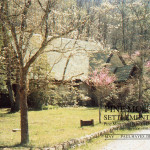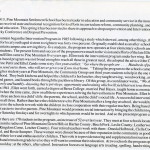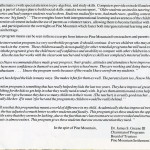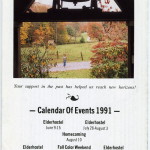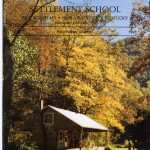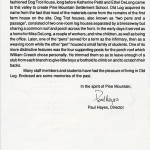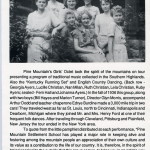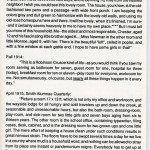Pine Mountain Settlement School
Series 17: PMSS PUBLICATIONS
Notes – 1991
Spring (May) and Fall
NOTES – 1991
“Notes from the Pine Mountain Settlement School”
Spring (May) and Fall 1991
GALLERY: NOTES – 1991 May
This spring [Pine Mountain School] has been invited to share its approach to dropout prevention and Intervention Program at the Kentucky Conference on Dropout Prevention.
- NOTES – 1991 May, page 1. [PMSS_notes_1991_may_0011.jpg]
- NOTES – 1991 May, page 2. [PMSS_notes_1991_may_0021.jpg]
- NOTES – 1991 May, page 3. [PMSS_notes_1991_may_0031.jpg]
- NOTES – 1991 May, page 4. [PMSS_notes_1991_may_0041.jpg]
TAGS: NOTES – 1991 May, Kentucky Conference on Dropout Prevention, Intervention Program, history, Ellen Hayes, Community Group, Paul Hayes, social interaction, fun days, local schools, teachers, Omeda Woods Holbrook, Clella Sargent Cook, Verna Mae Shepherd, Roxie Sumpter, computers, peer teaching, overnights, parents, tutors, Dr. James S. Greene III
TRANSCRIPTION: NOTES – 1991 May
P. 1
PINE MOUNTAIN
SETTLEMENT SCHOOL
PINE MOUNTAIN HARLAN COUNTY KENTUCKY
Telephone: (606) 558-3571 -3542
MAY PAUL HAYES, DIRECTOR 1991
[Featured color photograph: Chapel in the spring.]
P. 2
Dear Friend:
Since 1913, Pine Mountain Settlement School has been a leader in education and community service in the mountains. Over the years it has received state and national recognition for its efforts in curriculum reform, community planning, and environmental education. This spring it has been invited to share its approach to dropout prevention and Intervention Program, at the Kentucky Conference on Dropout Prevention.
Pine Mountain began the Intervention Program in 1985 following a study which showed, among other things, that the dropout rate for local youth aged sixteen to eighteen was forty-two percent. Originally established as an after-school program on the Pine Mountain campus [and] serving thirty-five students, the program now operates at four elementary schools and reaches 178 students. The present form and success of the program owe much to the vision and efforts of the late Ellen Hayes. When Paul and Ellen came to Pine Mountain five years ago, Ellen took the intervention program under her wing. Recognizing that a campus-based program was not broad enough to reach all those in greatest need, she adopted the advice John C. Campbell had given Katherine Pettit and Ethel Zande some sixty-five years earlier: “Go where the people are . . . Hundreds of people can be reached if you send out to them, who will never get to you if you sit at home.” Taking the program to the schools came naturally to Ellen. During her student years at Pine Mountain, the Community Group sent third years students to help in the one room schools of the neighborhood. They built kitchens and helped the children fix hot lunches; they taught sewing, woodworking, and crafts, led singing and games, and loaned books through the packhorse library. Of this group, its coordinator wrote, “We shall enter upon this work eagerly and humbly — knowing that is privilege, [opportunity] and training which will yield harvest to us throughout our lives.” Graduating in 1941, Ellen went forth, earned a degree at Berea College, married Paul Hayes, taught home economics, raised four children, and when the time came, drew on all these experiences to bring the harvest home to Pine Mountain. Ellen believed that there are three anchors in a child’s life: the parents, the school, and the child’s social life. A successful intervention program would build on all three. Rather than have the children travel to Pine Mountain after a long day at school, she would take retired teachers to the schools to work with the children in close cooperation with their regular teachers. Being based at the schools would make it easier to involve parents. Pine Mountain would promote social interaction by bringing the children together on campus for Saturday fun days and for overnights to which parents would be invited. And so the present program came together.
This year there are 178 students in the program, an increase of 52 over last year. They meet at four schools located within a fifteen mile radius of Pine Mountain (Green Hills in Harlan County; Beech Fork, Leslie County; Leatherwood, Perry County; and Kingdom Come, Letcher County). Four retired teachers work with them — Omeda Holbrook, Clella Cook, Verna Mae Shepherd, and Roxie Sumpter. These women were chosen because of their reputation in the community as good teachers and because of their love and enthusiasm for children. Their role is to provide tutoring and supplemental instruction to help children reach and remain on grade level so they will want to continue their education. At two schools the program operates during the school day; at the others, after school. Instruction focuses on language arts (reading, spelling, handwriting, and…
P. 3
…English), mathematics (with special attention to pre-algebra), and study skills. Computers provide extra drill and enrichment. Peer teaching is part of a larger plan to build social skills; stated a recent report, “Older students assisted in tutoring younger students. They read stories and had younger students read to them. Students studied for tests, had math races, spelling contests, and in reality became one ‘big family’.” The overnights foster both intergenerational learning and awareness of the children’s mountain heritage. Parent involvement includes the use of parents as volunteer tutors, allowing them to become familiar with new trends in education, and participation in the overnights at Pine Mountain which foster both intergenerational learning and appreciation of the mountain heritage.
What the program means can be seen in these excerpts from letters to Pine Mountain from teachers and parents:
“I feel that the intervention program is a very worthwhile program. It should continue. It serves children who may otherwise fall through the cracks in the system. These children usually do not qualify for other remedial programs but still need extra help. In my experience with the program it gives the child more self confidence and an ability to compete with other children in comparable grade levels. Also the teacher works with the classroom teacher and reinforces skills not completely mastered in the classroom settings. “The students I have recommended have made great progress; their grades, attitudes and attendance have improved tremendously. The students have more confidence in themselves and seem to enjoy school more. They are working and doing their assignments with more enthusiasm… I know the program works because of the results I have seen from my students.
“(The teacher) has helped the kids in many ways. She makes it fun for them as well. The parents learn too, I know I have.”
“The intervention program is something that has really helped my kids the last two years. They have improved greatly. I think it is really a good thing for the kids to get help in what they really need to study with. It gives them attention and extra help where their regular teacher can’t give because they have so many children in their room. (The teacher) is a really good teacher. She is good with the kids. They really like her. If it wasn’t for her and the program my children would be really behind.’
“I have to tell you that this program has meant a world of difference in my child. Academically she has improved tremendously and also socially she has adjusted so much better to other students and faculty. This program gives these students the opportunity to attain that little extra that they seem to be lacking, due to the fact that our classrooms are so overcrowded and instruction on a one to one basic is almost extinct. This program gives these students that one on one attention they need.”
In the [spirit] of Pine Mountain,
Dr. James S. Greene III
Chairman of Programs
Board of Trustees
Pine Mountain Settlement School
P. 4
[Color photograph: Fall foliage form a background for the Chapel bell.]
Your support in the past has helped us reach new horizons!
*
— Calendar Of Events 1991 —
Elderhostel
June 9-15
Elderhostel
July 28-August 3
Homecoming
August 10
Elderhostel
September 22-28
Fall Color Weekend
October 18-20
Elderhostel
November 10-16
Nativity Play
December 15
________________________________
Photo credit: Faye Trail Deaton
GALLERY: NOTES – 1991 Fall
…[I]n the spirit of “missionaries” to the outside…[the Pine Mountain Girls’ Octet] comes, to bring you in an artistic way the spirit of their mountains through their music. – Excerpt from a 1936 pamphlet distributed at performances.
- NOTES – 1991 Fall, page 1. [PMSS_notes_1991_fall_0011.jpg]
- NOTES – 1991 Fall, page 2. [PMSS_notes_1991_fall_0021.jpg]
- NOTES – 1991 Fall, age 3. [PMSS_notes_1991_fall_0031.jpg]
- NOTES – 1991 Fall, page 4. [PMSS_notes_1991_fall_0041.jpg]
- NOTES – 1991 Fall, page 5. [PMSS_notes_1991_fall_0051.jpg]
- NOTES – 1991 Fall, page 6. [PMSS_notes_1991_fall_0061.jpg]
TAGS: NOTES – 1991 FALL, Old Log, history, August Angel, Octet, music, running set, country dancing, Henry Ford, tour, mountain culture, White House, President Roosevelt, Eleanor Roosevelt, Ethel de Long, Miss Newman, Smith Alumnae Quarterly, photographs
TRANSCRIPTION: NOTES – 1991 Fall
P. 1
PINE MOUNTAIN
SETTLEMENT SCHOOL
PINE MOUNTAIN HARLAN COUNTY KENTUCKY
Telephone: (606) 558-3571
FALL PAUL HAYES, DIRECTOR 1991
[Featured color photograph: The Cabin among trees in fall colors.]
P. 2
When Ellen and I came back to Pine Mountain five years ago, to stay six months, we moved into the Turner apartment at Laurel House, two rooms, adequate for a little while. We soon found that we needed a place away from the center of all activity, which begins and ends at Laurel House. We decided it would be Old Log, reported to have been constructed 140 years ago as an old- fashioned Dog Trot House, long before Katherine Pettit and Ethel DeLong came to this valley to create Pine Mountain Settlement School. Old Log acquired its name from the fact that most of the materials came from the remains of the first farm house on the site. Dog Trot houses, also known as “two pens and a passage”, consisted of two one-room log houses separated by a breezeway but sharing a common roof and porch across the front. In the early days it served as a home for Miss DeLong, a couple of workers, and nine children, as well as being the office. Later, one of the “pens” served for a term as the infirmary, then as a weaving room while the other “pen” housed a small family of students. One of its more distinctive features was the four supporting posts for the porch roof which William Creech chose personally. He trimmed them so as to leave enough of a stub from each branch to give little boys a foothold to climb on and to scratch their backs.
Many staff members and students have had the pleasure of living in Old Log. Enclosed are some memories of the past.
In the spirit of Pine Mountain,
[Signed]
Paul Hayes, Director
P. 3
“Memories”
[Image: Photograph of the members of the Girls’ Octet.]
Pine Mountain’s Girls’ Octet took the spirit of the mountains on tour presenting a program of traditional music collected in the Southern Highlands. Also the “Kentucky Running Set” and English Country Dancing. (Back row – Georgia Ayers, Lucille Christian, Nan Milan, Ruth Christian, Lela Christian, Ruby Ayers; seated – Fern Hall and Johanna Ayers.) In the fall of 1936 this group, along with two boys (Bill Hayes and Marion Turner), Director Glyn Morris, accompanist Arthur Dodd and teacher-chaperone Edrye Burdine made a 3,000 mile trip in two cars! They traveled west as far as St. Louis, north to Cincinnati, Indianapolis and Dearborn, Michigan where they joined Mr. and Mrs. Henry Ford at one of their frequent folk dances. After traveling through Cleveland, Pittsburg[h] and Plainfield, New Jersey the tour ended in the New York area.
To quote from the little pamphlet distributed at each performance, “Pine Mountain Settlement School has played a major role in keeping alive and fostering among the mountain people an appreciation of their own culture and its value as a contribution to the life of our country. It is, therefore, in the spirit of ‘missionaries’ to the outside that this group comes, to bring you in an artistic way the spirit of their mountains through their music.”
April 6, 1937 the Octet performed in the East Room of the White House for President and Mrs. Roosevelt and their assembled guests.
P. 4
Ethel DeLong on Old Log
June 5, 1914, wrote to her mother:
“I have moved up to the dear old log house. It is perfectly wonderful to have a room of my own and my own things, that I packed last May, actually unpacked. And to have three little boys, and to be living 1/2 mile from the nearest neighbor! I wish you could see this lovely room. The house, you know, is the old- fashioned two pens and a passage — with wide front porch. I am keeping the colors gray and dull green to harmonize with the lovely old walls, and using my old-rose homespuns here and there. It will be lovely, when it’s finished, I’m sure- — and it certainly seems heavenly to me to have my own place.**** But I must tell you more of this household. Me — the oldest and most responsible, Chester, aged 12 and his fascinating little brother aged 6…; Miss [Eve] Newman in the other room and little Monroe, aged 9, with her. There is the beautiful “loft”, ceiled in poplar, and with a fine window at each gable end. I hope to have some girls in that!”
Fall 1914:
“This is a Robinson Crusoe kind of life — as you would think if you saw my room serving as bathroom for seven, guest room for one, hospital for three (today), breakfast room for ten or eleven — play room for everyone, workroom for me. Not simultaneously, of course, but nearly all these things happen in it every day.”
April 1915, Smith Alumnae Quarterly:
“Picture a room 17 x 13 ft. which is not only my office and workroom, and the wayside lodge for all hungry and cold travelers up and down the creek, at seasonable and unseasonable hours, but also the bath-room, dressing-room, play-room, and sick-room for two little girls and seven boys aging from six to thirteen years. The other room is the school office, containing typewriter, filing cases, desk, cabinet, and is the dressing room for two grown-ups and one little girl. The mere effort of keeping a house clean under such conditions results in great nervous strain. The floors have to be swept several times a day for we live in a country where mud is a household word, and nothing can be allowed to stray from its place one instant or pandemonium reigns. Everybody has to get up at five in the morning whether he is well or ill. Fortunately the children who are used to living under such conditions do not feel any strain, and we three grown-ups are “stout” enough to have come through pretty well so far.”
P. 5
Uncle Ted at Old Log
The year was 1940 and ‘Little Abner’ comics depicting the typical Kentucky mountaineer were all the rage.
Susie [Hall Angel] and I were living in Old Log when we welcomed as a guest my Uncle Ted, who planned to spend several weeks at the school. It was his first visit to Kentucky. His late arrival afforded no time for a look at the school campus so we opt for a snack, talk and to retire early.
Over a cup of tea, Uncle Ted was curious about shooting and feuding tales he had hear regarding mountain life. In response, we assured him not to worry. Shootings and feuding did not pertain to outsiders — he would be subject to no harm.
Uncle Ted was shown his cot underneath a window facing the road up to the Infirmary. After resting only a few minutes a thunderous shotgun blast sounded and a shower of splintered glass fell upon my startled and somewhat frightened uncle who just moments earlier was promised a restful visit at the school. Luckily he was not hurt, just nerves on edge.
An alarm at the door prompted me to open it and there stood the night watchman — his face, arms and chest covered with blood and asking for help. He was immediately taken to the Infirmary and luckily treated for superficial ‘pellet’ wounds.
As for the shooting the night watchman’s ring-in station was aside the window where Uncle Ted was resting. A cousin of the night watchman coveted the job and thought an ambush would scare his relative to quit so he would be available.
Uncle Ted learned first hand about shooting and feuding. Very early the next morning he departed without a tour of the campus.
P. 6
[Image: Small sketch of two pine trees in mountainous landscape.]
As we strive to upgrade the physical plant, we need to replace furnaces before winter in the following buildings:
Office $2550.00
Zande House 2900.00
Library 5600.00
Chapel 2900.00
Clinic (infirmary) 2980.00
We thank you for your support in the past.
Paul Hayes, Director
CALENDAR OF EVENTS
1992
Elderhostel
February 23-29
Elderhostel
June 14-20
Elderhostel
September 20-26
Wildflower Weekend
April 24-26
Black Mtn. Weekend
May 8-10
Elderhostel
July 26-August 1
Fall Color Weekend
October 23-25
Nativity Play
December 13
Homecoming
August 8
Elderhostel
November 15-21
Previous:
NOTES – 1990
Next:
NOTES – 1992
See Also:
EDUCATION
HISTORY PMSS Summary 1990-1991
HISTORY PMSS Summary 1991-1992
Return To:
NOTES Index

